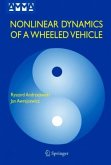This monograph provides an overview of the theory of stability analysis and its applications. It focuses on various methods for analyzing wheeled vehicle behavior. The authors provide both basic and advanced knowledge of the subject. The book summarizes their research experience and extensive teaching. A large number of practical examples are included throughout to help readers understand the theory introduced.
The book has several original features:
- The stability analysis of nonlinear systems that is carried out utilizes the definitions of stability in the sense of Lapunov ("mathematical stability") and the definitions of stability in the sense of Bogusz ("technical stability").
- The book emphasizes stability analysis of wheeled vehicles and their systems.
- Computer-aided methods for investigations of wheeled vehicle behaviors are discussed.
On average, 60% of the world's people and cargo is transported by vehicle that move on rubber tires over roadways of various construction, composition, and quality. The number of such vehicles, including automobiles and all manner of trucks, increases continually with a growing positive impact on accessibility and a growing negative impact on interactions among humans and their relationship to the surrounding environment. This multiplicity of vehicles, through their physical impact and their emissions, is responsible for, among other negative results: waste of energy, pollution through emission of harmful compounds, degradation of road surfaces, crowding of roads leading to waste of time and increase of social stress, and decrease in safety and comfort. In particular, the safety of vehicular traffic depends on a man-vehicle-road system that includes both active and passive security controls. In spite of the drawbacks mentioned above, the governments of almost every country in theworld not only expect but facilitate improvements in vehicular transport performance in order to increase such parameters as load capacity and driving velocity, while decreasing such parameters as costs to passengers, energy resources investments, fuel consumption, etc. Some of the problems have clear, if not always easily attainable, solutions.
The book has several original features:
- The stability analysis of nonlinear systems that is carried out utilizes the definitions of stability in the sense of Lapunov ("mathematical stability") and the definitions of stability in the sense of Bogusz ("technical stability").
- The book emphasizes stability analysis of wheeled vehicles and their systems.
- Computer-aided methods for investigations of wheeled vehicle behaviors are discussed.
On average, 60% of the world's people and cargo is transported by vehicle that move on rubber tires over roadways of various construction, composition, and quality. The number of such vehicles, including automobiles and all manner of trucks, increases continually with a growing positive impact on accessibility and a growing negative impact on interactions among humans and their relationship to the surrounding environment. This multiplicity of vehicles, through their physical impact and their emissions, is responsible for, among other negative results: waste of energy, pollution through emission of harmful compounds, degradation of road surfaces, crowding of roads leading to waste of time and increase of social stress, and decrease in safety and comfort. In particular, the safety of vehicular traffic depends on a man-vehicle-road system that includes both active and passive security controls. In spite of the drawbacks mentioned above, the governments of almost every country in theworld not only expect but facilitate improvements in vehicular transport performance in order to increase such parameters as load capacity and driving velocity, while decreasing such parameters as costs to passengers, energy resources investments, fuel consumption, etc. Some of the problems have clear, if not always easily attainable, solutions.
From the reviews of the first edition: "This is a monograph focusing on various modes of roadway vehicle (wheeled vehicle) stability. ... The authors propose new theoretical, numerical, and experimental approaches to this general area of vehicle dynamics. ... This reviewer believes the book will indeed provide useful information for a wide class of readers ... . Over one hundred references are given for additional study." (Ronald L. Huston, Zentralblatt MATH, Vol. 1070, 2005)








